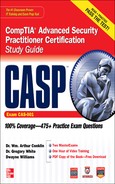0%
39Chapters
0-1Hours read
0kTotal Words
Book Description
The best fully integrated study system available for CompTIA Advanced Security Practitioner (CASP) Exam CAS-001 With hundreds of practice questions and lab exercises, CASP CompTIA Advanced Security Practitioner Certification Study Guide covers what you need to know—and shows you how to prepare—for this challenging exam.
Book Description
The best fully integrated study system available for CompTIA Advanced Security Practitioner (CASP) Exam CAS-001 With hundreds of practice questions and lab exercises, CASP CompTIA Advanced Security Practitioner Certification Study Guide covers what you need to know—and shows you how to prepare—for this challenging exam.
Table of Contents
- Cover Page
- CASP™ CompTIA® Advanced Security Practitioner Certification Study Guide (Exam CAS-001)
- Copyright Page
- Dedication
- About the Authors
- Contents
- Preface
- Acknowledgments
- Introduction
- Part I Enterprise Security
- 1 Cryptographic Tools
- Determine Appropriate Tools and Techniques
- Advanced PKI Concepts
- Hashing
- Cryptographic Applications
- Digital Signatures
- Code Signing
- Nonrepudiation
- Transport Encryption
- Implications of Cryptographic Methods and Design
- Entropy
- Pseudorandom Number Generation
- Perfect Forward Secrecy
- Confusion
- Diffusion
- ✔ Two-Minute Drill
- Q&A Self Test
- 2 Computing Platforms
- Advantages and Disadvantages of Virtualizing Servers and Minimizing Physical Space Requirements
- VLAN
- Securing Virtual Environments, Appliances, and Equipment
- Vulnerabilities Associated with a Single Physical Server Hosting Multiple Companies’ Virtual Machines
- Vulnerabilities Associated with a Single Platform Hosting Multiple Companies’ Virtual Machines
- Secure Use of On-demand/Elastic Cloud Computing
- Vulnerabilities Associated with Co-mingling of Hosts with Different Security Requirements
- Virtual Desktop Infrastructure (VDI)
- Terminal Services
- ✔ Two-Minute Drill
- Q&A Self Test
- 3 Enterprise Storage
- 4 Infrastructure
- Advanced Network Design
- Complex Network Security Solutions for Data Flow
- Secure Data Flows to Meet Changing Business Needs
- Secure DNS
- Secure Directory Services
- Network Design Consideration
- Multitier Networking Data Design Considerations
- Logical Deployment Diagram and Corresponding Physical Deployment Diagram of All Relevant Devices
- Secure Infrastructure Design
- Storage Integration
- Advanced Configuration of Routers, Switches, and Other Network Devices
- ESB
- SOA
- SIEM
- Database Access Monitor (DAM)
- Service Enabled
- WS-Security
- ✔ Two-Minute Drill
- Q&A Self Test
- 5 Host Security Controls
- 6 Application Security
- Web Application Security Design Considerations
- Specific Application Issues
- Application Sandboxing
- Application Security Frameworks
- Secure Coding Standards
- Exploits Resulting from Improper Error and Exception Handling
- Privilege Escalation
- Improper Storage of Sensitive Data
- Fuzzing/False Injection
- Secure Cookie Storage and Transmission
- Client-Side Processing vs. Server-Side Processing
- Buffer Overflow
- Integer Overflows
- Memory Leaks
- Race Conditions
- Time of Use
- Resource Exhaustion
- ✔ Two-Minute Drill
- Q&A Self Test
- 7 Security Assessments
- 1 Cryptographic Tools
- Part II Risk Management, Policy/Procedure, and Legal
- 8 Analyze Risk Implications
- 9 Risk Management Strategy and Controls
- Classify Information Types into Levels of CIA Based on Organization/Industry
- Determine the Aggregate Score of CIA
- Determine the Minimum Required Security Controls Based on Aggregate Score
- Conduct System-Specific Risk Analysis
- Make Risk Determination
- Decide Which Security Controls Should Be Applied Based on Minimum Requirements
- Implement Controls
- Enterprise Security Architecture (ESA) Frameworks
- Continuous Monitoring
- ✔ Two-Minute Drill
- Q&A Self Test
- 10 E-discovery, Data Breaches, and Incident Response
- 11 Security and Privacy Policies
- Policy Development and Updates in Light of New Business, Technology, and Environment Changes
- Process/Procedure Development and Updates in Light of Policy, Environment, and Business Changes
- Support Legal Compliance and Advocacy by Partnering with HR, Legal, Management, and Other Entities
- Use Common Business Documents to Support Security
- Use General Privacy Principles for PII/Sensitive PII
- Support the Development of Policies
- ✔ Two-Minute Drill
- Q&A Self Test
- Part III Research and Analysis
- 12 Industry Trends
- 13 Enterprise Security
- Benchmark
- Prototype and Test Multiple Solutions
- Cost Benefit Analysis (ROI, TCO)
- Analyze and Interpret Trend Data to Anticipate Cyber Defense Aids
- Review Effectiveness of Existing Security
- Reverse-Engineer/Deconstruct Existing Solutions
- Analyze Security Solutions to Ensure They Meet Business Needs
- Conduct a Lessons-Learned/After-Action Review
- Use Judgment to Solve Difficult Problems That Do Not Have a Best Solution
- Conduct Network Traffic Analysis
- ✔ Two-Minute Drill
- Q&A Self Test
- Lab Question
- Part IV Integration of Computing, Communications and Business Disciplines
- 14 People and Security
- 15 Change Control
- 16 Security Controls for Communication and Collaboration
- 17 Advanced Authentication Tools, Techniques, and Concepts
- 18 Security Activities Across the Technology Life Cycle
- Appendix About the Download
- Glossary
- Index
